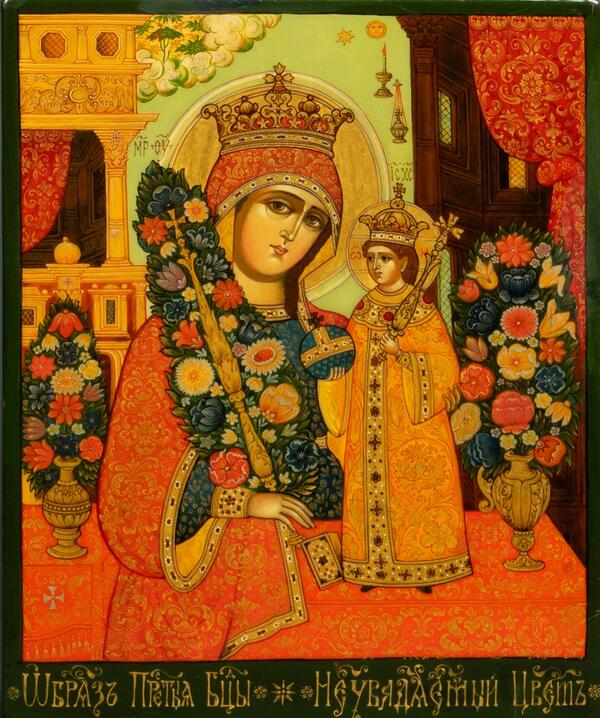The icon ‘The Virgin of the Unfading Rose’ is a picturesque copy of the famous 1691 icon of the same name by Tikhon Filatyev from the Church of the Nativity of the Theotokos in Golutvinsky Lane in Moscow.
This iconographic type (an established way of depicting a subject) was formed on the basis of the texts of Byzantine Akathist Hymn — chants dedicated to the Virgin. In them, the Virgin Mary is referred to as ‘the flower of incorruptibility’, ‘Aaron’s Rod’, “the unfading rod”. This iconographic type originated from the poetic image of the “unfading rose”. In Russia, it appeared, most likely, due to the painting of the churches of the Moscow Kremlin in the second half of the 17th century: at that time artists drew inspiration from the Akathist Hymn to the Virgin.
“The Virgin of the Unfading Rose” is usually depicted in a royal crown and with a rod in her right hand, which blooms with heavenly flowers. This is a reference to the Old Testament image of the Virgin Mary as the “rod out of the stem of Jesse”. With her left hand, the Holy Virgin supports the infant Christ in royal robes: he stands on the throne in a crown, with a scepter and an orb in his hands. The composition of the icon is replete with Old Testament symbols of the mother of Jesus: a candle, the tree of life, a thurible, a tsar’s palace, a star.
The icon displayed in the museum was painted by Palekh artist Tatyana Khodova. It is important to note that she created not simply a copy of the old painting by Filatyev: the face of the mother of Jesus on the Palekh icon is much softer, tender, without that note of sadness that is present in Filatyev’s one. The flowers on the rod are meticulously and finely painted, in accordance with Palekh rules.
The artist paid attention to the color scheme of the icon. She created it based on a combination of golden yellow, cinnabar red, orange and brown colors. As the color scheme is very warm, the icon brings a feeling of light, joy and peace. Traditionally, this icon is considered the patron icon of marriage — people pray to it for family happiness.
Tatyana Khodova is an Honored Artist of Russia and a member of the Artists’ Union. She was born in 1942 in the city of Shuya, Ivanovo Oblast. In 1959-1964, she studied at the Palekh Art School, and since 1964 she has worked in the Palekh Art Production Workshops. In 1992, she participated in the creation of the iconostasis for the Palekh Church of Elijah the Prophet. Her works are mainly characterized by folklore imagery, depictions of literary and genre scenes.
This iconographic type (an established way of depicting a subject) was formed on the basis of the texts of Byzantine Akathist Hymn — chants dedicated to the Virgin. In them, the Virgin Mary is referred to as ‘the flower of incorruptibility’, ‘Aaron’s Rod’, “the unfading rod”. This iconographic type originated from the poetic image of the “unfading rose”. In Russia, it appeared, most likely, due to the painting of the churches of the Moscow Kremlin in the second half of the 17th century: at that time artists drew inspiration from the Akathist Hymn to the Virgin.
“The Virgin of the Unfading Rose” is usually depicted in a royal crown and with a rod in her right hand, which blooms with heavenly flowers. This is a reference to the Old Testament image of the Virgin Mary as the “rod out of the stem of Jesse”. With her left hand, the Holy Virgin supports the infant Christ in royal robes: he stands on the throne in a crown, with a scepter and an orb in his hands. The composition of the icon is replete with Old Testament symbols of the mother of Jesus: a candle, the tree of life, a thurible, a tsar’s palace, a star.
The icon displayed in the museum was painted by Palekh artist Tatyana Khodova. It is important to note that she created not simply a copy of the old painting by Filatyev: the face of the mother of Jesus on the Palekh icon is much softer, tender, without that note of sadness that is present in Filatyev’s one. The flowers on the rod are meticulously and finely painted, in accordance with Palekh rules.
The artist paid attention to the color scheme of the icon. She created it based on a combination of golden yellow, cinnabar red, orange and brown colors. As the color scheme is very warm, the icon brings a feeling of light, joy and peace. Traditionally, this icon is considered the patron icon of marriage — people pray to it for family happiness.
Tatyana Khodova is an Honored Artist of Russia and a member of the Artists’ Union. She was born in 1942 in the city of Shuya, Ivanovo Oblast. In 1959-1964, she studied at the Palekh Art School, and since 1964 she has worked in the Palekh Art Production Workshops. In 1992, she participated in the creation of the iconostasis for the Palekh Church of Elijah the Prophet. Her works are mainly characterized by folklore imagery, depictions of literary and genre scenes.


